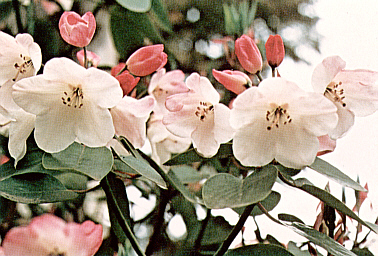QBARS - v28n4 R. souliei, F2 Cox
R. souliei, F2 Cox
Carl H. Phetteplace, M.D., Eugene, Oregon

|
|
R. souliei
Photo by Carl Phetteplace, M. D. |
Descriptions of R. souliei in the literature long ago impressed me that here was a very desirable garden species. Although rated hardy enough for our climate there were not many plants to be found. Of those seen there were so many variations among them that some must be hybrids at best.
One of the high points of my visit to Great Britain in 1960 was the visit to the Cox garden at Glendoick where the R. souliei were in full flower. Here were some forms varying mainly in color, shades of pink and white, but basically so similar and distinctive that speciesity could hardly be questioned. Mr. Cox (E. H. M.) told me that the source of these plants was originally from the Abbey in France where the species was first introduced by the missionary in Tibet, Pere J. A. Soulie, for whom it was named. All forms had the same five-lobed saucer-shaped flower, ranging from a clear persistent pink to pure white when fully open. Mr. Cox said there was really no difference between the white R. souliei and R. puralbum except the white R. souliei was pink in the bud and faded to white on opening, while R. puralbum is white in both bud and flower.
After returning home, Mr. Cox sent me cuttings of these plants for a year or two, but I was unable to succeed by any means to propagate them. About this time Bob Bovee told me that he had imported about 300 cuttings of R. souliei over some years and had succeeded in rooting only one, which expired after a year or two.
After these failures Mr. Cox advised that the only possibility of my establishing the species was for him to self his flowers saying that, If I self anything you can be very sure every precaution is taken to prevent contamination.
The next year I received packets of seed variously labeled Best Pink, Original form, White Souliei, etc. There was no problem growing them and the plants now range from three and one-half to five feet in height, at twelve years from seed. Some have flowered at least six years. The temperature of minus 6°F. of December, 1972 did no harm to plants and insignificant damage to buds. The 6°F. of January, 1974 with no snow cover was harmless. The white form is noticeably more vigorous in growth than the pink with somewhat more lush foliage.
The accompanying picture confirms the lovely pink bud fading to white described by Mr. Cox in the white form, and also is a testimonial to his care in hand pollination. I have never been successful in rooting or ordinary grafting of any of these plants. It seems I did send a little hand pollinated seed to the Exchange about four years ago and I do have a few small plants of the pink form. I hope to do better by you next year, Mrs. Berry.
